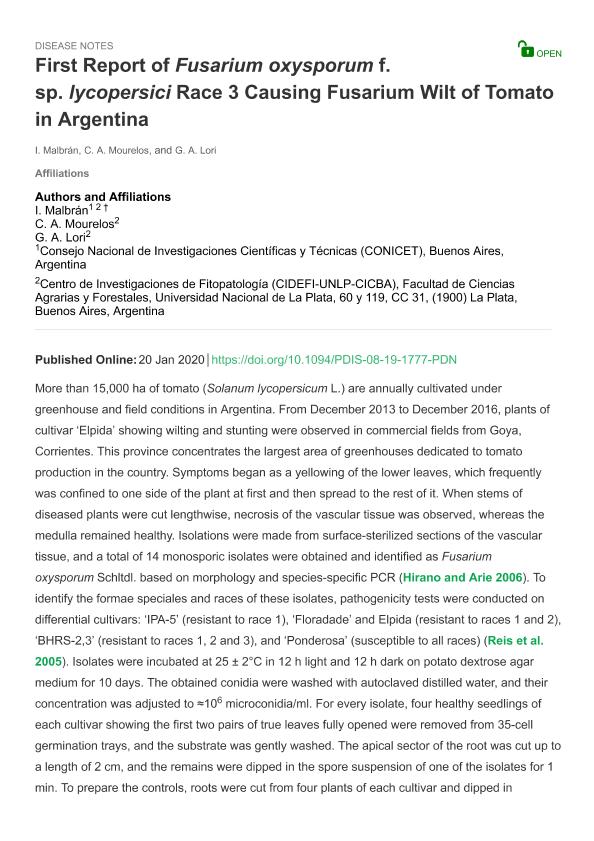Artículo
First report of Fusarium oxysporum f. sp. lycopersici Race 3 Causing Fusarium Wilt of Tomato in Argentina
Fecha de publicación:
03/2020
Editorial:
American Phytopathological Society
Revista:
Plant Disease
ISSN:
0191-2917
e-ISSN:
1943-7692
Idioma:
Inglés
Tipo de recurso:
Artículo publicado
Clasificación temática:
Resumen
More than 15,000 ha of tomato (Solanum lycopersicum L.) are annually cultivated under greenhouse and field conditions in Argentina. From December 2013 to December 2016, plants of cultivar ‘Elpida’ showing wilting and stunting were observed in commercial fields from Goya, Corrientes. This province concentrates the largest area of greenhouses dedicated to tomato production in the country. Symptoms began as a yellowing of the lower leaves, which frequently was confined to one side of the plant at first and then spread to the rest of it. When stems of diseased plants were cut lengthwise, necrosis of the vascular tissue was observed, whereas the medulla remained healthy. Isolations were made from surface-sterilized sections of the vascular tissue, and a total of 14 monosporic isolates were obtained and identified as Fusarium oxysporum Schltdl. based on morphology and species-specific PCR (Hirano and Arie 2006). To identify the formae speciales and races of these isolates, pathogenicity tests were conducted on differential cultivars: ‘IPA-5’ (resistant to race 1), ‘Floradade’ and Elpida (resistant to races 1 and 2), ‘BHRS-2,3’ (resistant to races 1, 2 and 3), and ‘Ponderosa’ (susceptible to all races) (Reis et al. 2005). Isolates were incubated at 25 ± 2°C in 12 h light and 12 h dark on potato dextrose agar medium for 10 days. The obtained conidia were washed with autoclaved distilled water, and their concentration was adjusted to ≈106 microconidia/ml. For every isolate, four healthy seedlings of each cultivar showing the first two pairs of true leaves fully opened were removed from 35-cell germination trays, and the substrate was gently washed. The apical sector of the root was cut up to a length of 2 cm, and the remains were dipped in the spore suspension of one of the isolates for 1 min. To prepare the controls, roots were cut from four plants of each cultivar and dipped in sterilized distilled water. Afterward, the seedlings were transferred to 0.5-liter pots containing a mixture of tindalized soil, compost, and perlite (5:4:1 v/v) and grown in a greenhouse under natural daylight. Plants were evaluated 28 days postinoculation. All isolates induced typical symptoms of Fusarium wilt of tomato on cultivars Ponderosa, IPA-5, Elpida, and Floradade but not on cultivar BHRS-2,3 and hence were identified as F. oxysporum f. sp. lycopersici (Sacc.) W.C. Snyder & H.N. Hansen race 3. The pathogen was reisolated from vascular tissues of symptomatic plants from the three susceptible cultivars but not from control plants. To our knowledge, this is the first formal report of F. oxysporum f. sp. lycopersici race 3 in Corrientes, Argentina. The pathogen constitutes a potential threat to tomato production in this important area of production, and the knowledge of its presence might aid farmers in the selection of cultivars.
Palabras clave:
FUNGI
,
EPIDEMIOLOGY
,
FIELD CROPS
Archivos asociados
Licencia
Identificadores
Colecciones
Articulos(CCT - LA PLATA)
Articulos de CTRO.CIENTIFICO TECNOL.CONICET - LA PLATA
Articulos de CTRO.CIENTIFICO TECNOL.CONICET - LA PLATA
Citación
Malbrán, Ismael; Mourelos, Cecilia Alejandra; Lori, Gladys; First report of Fusarium oxysporum f. sp. lycopersici Race 3 Causing Fusarium Wilt of Tomato in Argentina; American Phytopathological Society; Plant Disease; 104; 3; 3-2020; 978-978
Compartir
Altmétricas




